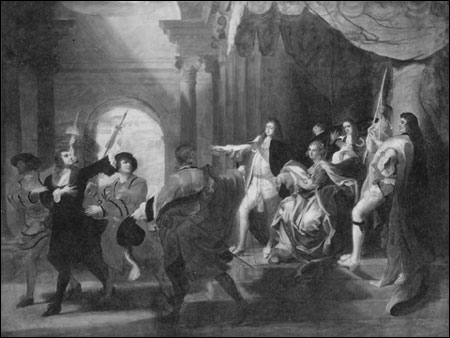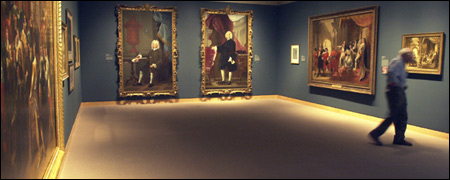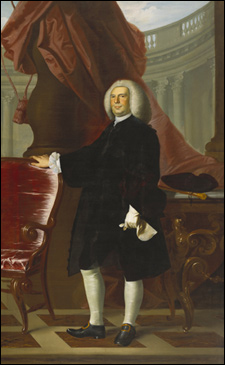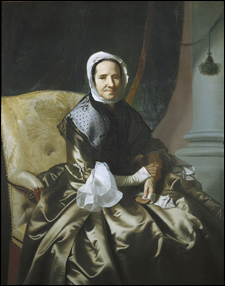Boston’s ‘pre-eminent portraitist’
Fogg’s Copley exhibit provokes, moves viewer with history as well as art

John Singleton Copley’s portraits of 18th century Boston’s grim-visaged elite are as integral a part of the image of the Colonial city as the Old North Church, Faneuil Hall, or Paul Revere’s house.
The works seem so quintessentially American that it is surprising to learn that in 1774, on the eve of the Revolution, Copley left Boston for London, never to return. He made the trip at the age of 36, having already established himself as Boston’s pre-eminent portraitist, and having proven, by marrying into a wealthy and prominent local family, that even in the culturally deprived and aesthetically backward Colonies, a painter could aspire to be something more than a mere artisan.
Following a tour of France and Italy to study European masterpieces (before this, Copley had never seen a good painting), he brought his family over and established himself in the British capital. Soon he was painting portraits of the English aristocracy, trading the hard-edged style of his Boston portraits for a freer, more romantic style resembling that of the fashionable portraitist Sir Joshua Reynolds.
And taking a cue from Benjamin West, another prodigy from the wilds of America who had taken the London art world by storm, he began to try his hand at history painting, then considered the most elevated artistic genre.

These huge canvases, commemorating an important event of the recent or remote past, were extremely popular at the time, corresponding perhaps to a BBC miniseries today. One of Copley’s most significant efforts in this line is now on display in the Fogg Museum, forming the centerpiece of a fascinating and rewarding exhibition titled “Process and Paradox: The Historical Pictures of John Singleton Copley.”
The painting is “Charles I Demanding the Five Impeached Members of the House of Commons.” First exhibited in 1795, it depicts an event that took place more than 150 years earlier. Five members of the House of Commons had been accused of treason, and Charles went there himself to demand their surrender. Copley portrays William Lenthall, the somberly clad speaker, falling on his knees before the foppish king and respectfully refusing to comply. It was the first act in a long struggle that was to culminate eight years later in the king’s execution.
The painting belongs to the Boston Public Library (BPL). Purchased in 1859, it hung for many years high on a wall in the De Cheverus Room, and by the end of the 20th century it had become dirty and discolored. The few visitors who noticed the painting or were aware of its significance must have been frustrated by its poor condition and inaccessibility.
Then Harvard’s Straus Conservation Center undertook the restoration of the painting as part of its project to restore the BPL’s John Singer Sargent and

Edwin Austen Abbey murals. The painting has spent more than a year in the lab having its surface grime and layers of yellowed varnish removed, said Teri Hensick, paintings conservator for the Straus Center. Its rich colors now glow with jewel-like intensity, and for the first time in many years, viewers can inspect its myriad details at eye level.
Those details are worth inspecting if only for the amount of research that went into them. Copley, whose renown as a portraitist derived from the unflinching accuracy of his likenesses, brought the same exactitude to his history paintings. For his first great history painting, “The Siege of Gibraltar,” he traveled to Germany to paint from life the faces of the Hanoverian officers who had taken part in the battle.
For “Charles I” he traveled around England copying 17th century portraits of the men who were likely to have been present at the event, weaving 58 of these faces into the final painting. The picture took him 14 years to complete, although he did put it aside several times to work on other projects.
“It’s a unique painting in his oeuvre,” said Kimberly Orcutt, the exhibition’s curator. “Most of his history paintings are of recent events. This is the first time he’s turning to a historical subject.”
Orcutt, assistant curator of American art at the Fogg Museum, believes that the

painting also throws light on Copley’s political beliefs. Considered by many to be a Tory because of his close ties to Boston’s wealthy merchant class, Copley’s life actually presents a more complex picture. Raised by a widowed mother who ran a tobacco shop on the Boston waterfront, Copley pulled himself into the upper classes through talent and hard work. His father-in-law, an agent for the East India Company, was one of the consignees whose shipment of tea was dumped into the harbor in the Boston Tea Party of 1773. Copley acted unsuccessfully as a negotiator between the merchants and the rebels, an experience he found draining and upsetting, and which may have influenced his decision to leave the troubled, chaotic Colony the following year.
Once in England, however, his support for the country he had abandoned seemed to grow stronger. Career advancement would have called for him to ingratiate himself with the royal family as his colleague West had done, but in “Charles I” and other paintings, he seemed deliberately to have chosen antimonarchical subjects. These choices did not go unnoticed. When Queen Charlotte, wife of George III, viewed the picture, she remarked, “You have chosen, Mr. Copley, a most unfortunate subject for the exercise of your pencil.”
Another painting in the Fogg exhibition, the unfinished “Monmouth Before James II,” shows another instance of a rebel defying a British monarch. Even “The Death of Chatham,” represented here in the form of a preparatory oil sketch, can be seen as another expression of the same democratic impulse. It depicts William Pitt, First Earl of Chatham, collapsing from a stroke while addressing the House of Lords. During the Colonies’ struggle against British injustice, Pitt was America’s strongest ally in Parliament.
In addition to these works, the exhibition also includes several of Copley’s
‘Process and Paradox: The Historical Pictures of John Singleton Copley’ is on view at the Fogg Museum, 32 Quincy St., through Aug. 29. Visit http://www.artmuseums.harvard.edu for more information.
early Boston portraits, the rotund and self-satisfied “Thomas Hollis,” the stalwart “Thomas Hancock” (uncle of John), and the superb “Mrs. Thomas Boylston Sr.,” considered one of the finest achievements of Copley’s American period.
For contrast, there is the portrait of Mrs. Daniel Denison Rogers, executed in England 10 years after the Boylston portrait. In contrast to the dark, somber interior of the earlier painting, Mrs. Rogers poses in an outdoor setting, her flimsy shawl lifted by the wind and almost indistinguishable from the swirling clouds behind her. And yet despite these fashionable touches, there remains something of the old Copley’s penetrating observation of character. Beneath the fantastic hat, Mrs. Rogers’ pale, thin-lipped face gazes at us with an expression of reserve and disillusionment.
The exhibition also includes Copley’s full-length portrait of John Adams, executed in 1783, following Adams’ successful negotiation of the Treaty of Paris, which ended the American Revolution.
One can’t help wondering what the two might have said to one another during their hours in Copley’s studio. Did Copley press the future president for news about America, its plans, its prospects, its political debates? Did Adams urge Copley to return to Boston and dedicate his artistry to the new republic? We do know that in later life, Copley expressed regret at not having returned to America. And for an art historian, it is difficult not to speculate about what he might have achieved if he had done so.
“With his commitment to historical painting, perhaps he might have done a series of paintings commemorating the events of the Revolution,” Orcutt said.
What an exhibition that would have made!




